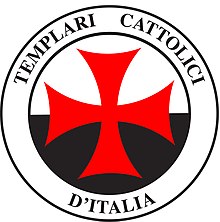Templari Cattolici d'Italia
| Templari Cattolici d'Italia | |
|---|---|
 Emblem of the Order | |
| Country | Italy |
| Religious affiliation | Roman Catholic |
| Eligibility | Italian civilian |
| Website | templarioggi |

The Templari Cattolici d'Italia is the Knights Templar order reconstituted in Italy[1] after the Templars were abolished on 22 March 1312 by the papal bull, Vox in excelso, issued by Pope Clement V.
History[]
Currently the order is not recognized by the Holy See as the Knights of Malta, but negotiations are under way.[1] The order is recognized by eight Italian dioceses (including Verona, Naples and Ascoli) to keep open shrines, preserve places of worship and help priests. They are present in 150 locations in Italy and have 1200 members.
It is not a secret or masonic association.[1]
| Part of a series on the |
| Knights Templar |
|---|
 |
|
Poor Fellow-Soldiers of Christ and of the Temple of Solomon |
| Overview |
| Councils |
| Papal bulls |
|
| Locations |
| Successors |
| Cultural references |
| See also |
|
|
|
Grades and badges[]
Insignia[]

The white representing the Spirit and is obviously above the black which represents matter, as well highlighted by the Templar frescoes of the counterface of St. Bevignate in Perugia in which the Knight Templar carries shield and bipartite beauceant in which the white is at the top and the black on the bottom.
Master General[]
| # | Arms | Name | Time in office |
|---|---|---|---|
| 1. | Mauro Giorgio Ferretti | 1990–present |
Headquarters[]
- Chiesa di San Fermo Maggiore, via della Dogana, 2 – 37121, Verona, Italy
The discovery of the tomb of the Grand Master of the Knights Templar Arnold of Torroja[]
In 2018 a sarcophagus was discovered in the cloister of the church of San Fermo Maggiore, Verona, containing the remains of the Grand Master of the Knights Templar, Arnold of Torroja.[2][3][4]
| # | Arms | Name | Time in office |
|---|---|---|---|
| 9. | 
|
Arnold of Torroja | 1181–1184 |
Locations[]
- Basilica di San Petronio, Bologna, Italy
- Abbazia di San Mercuriale, Forlì, Italy
- Chiesa dei Santi Pietro e Biagio, Cividale, Italy
- Chiesa di San Nicolò, Jesi, Italy
- Pieve di Santa Maria in acquedotto, Forlì, Italy
- Abbazia di Chiaravalle della Colomba, Alseno, Piacenza, Italy
- Sacra di San Michele, Turin, Italy
- Chiesa dell’Immacolata, Gorizia, Italy
- Beata Vergine Immacolata e S. Antonio, Milan, Italy
- Chiesa dei Santi Pietro e Paolo, Como, Italy
- Chiesa di San Michele Arcangelo, Cavaglià, Turin, Italy
The association is actively involved in the recovery, reopening and presiding of places of worship that have suffered over time abandonment, closure, deterioration or even worse desecration end 200 and more places are kept by the Templars.
Churches recovered[]
- Santa Maria delle Mose, Piacenza, Italy
- Chiesa dell’antico villaggio di Canossa, Reggio Emilia, Italy
- Saint Anna, Busseto, Parma, Italy
- Santa Maria Maddalena, Cerro di Toccalmatto, Fontanellato, Parma, Italy
- Santa Maria di Mucciatella, Puianello di Quattro Castella, Reggio Emilia, Italy
- Santuario della Beata Vergine Maria del Suffragio dei Poveri, Piacenza, Italy
- Oratorio di Santa Maria Immacolata, Parma, Italy
- Chiesa di Santa Maria delle Grazie al Moiariello, Capodimonte, Naples, Italy
- Chiesa di San Vincenzo, Cremona, Italy
See also[]
References[]
- ^ a b c "Le trattative e il sogno nascosto: il ritorno dei templari in Vaticano". ilgiornale.it. ilgiornale.it. 15 September 2020. Retrieved 15 September 2020.
- ^ "Scoperta la tomba del gran maestro: articolo dell'Università di Salisurgo". templarioggi.it. templarioggi.it. Retrieved 25 September 2020.
- ^ "Grab eines Großmeisters entdeckt". science.orf.at. science.orf.at. Retrieved 25 September 2020.
- ^ "Il sarcofago ritrovato a Verona e i Templari". templarioggi.it. templarioggi.it. Retrieved 25 September 2020.
- Knights Templar
- Religious organisations based in Italy
- Italian organisation stubs